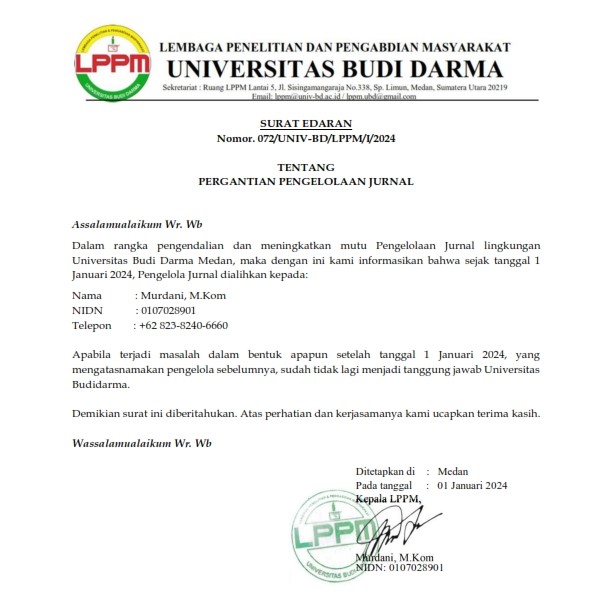Penerapan Klasifikasi Untuk Kelayakan Hasil Produksi Jam Tangan dengan Menggunakan Algoritma K-Nearest Neighbor
DOI:
https://doi.org/10.30865/jurikom.v9i6.5216Keywords:
Filterization, Industry, K-Nearest Neighbor, Quality Control, ManufactureAbstract
Industrial companies in Indonesia are one of the sectors that require development in carrying out their contribution in the manufacturing world. Market needs become the main guideline for the industry to create new ideas and improve the quality of production. Most industries, including digital watch electronics companies, have a need to implement technology at every stage of manufacturing their goods, such as at the stage of filtering raw materials to checking quality control before the goods reach consumers. Filtering and quality control are carried out to maintain the quality of each product produced by the company. The problem discussed in this study is how to apply technology in detecting the quality of watch production using the K-Nearest Neighbor algorithm so that it can increase the quality of production, consumer confidence and increase profits for the company. The results of this study are that the model built using the K-Nearest Neighbor method can increase the accuracy for detecting quality control on watch products with an accuracy value of 92% for k = 3References
E. Kaasinen et al., “Empowering and engaging industrial workers with Operator 4.0 solutions,†Comput. Ind. Eng., vol. 139, 2020, doi: 10.1016/j.cie.2019.01.052.
S. Wang, Q. Hu, and W. Liu, “Price and quality-based competition and channel structure with consumer loyalty,†Eur. J. Oper. Res., vol. 262, no. 2, pp. 563–574, 2017, doi: 10.1016/j.ejor.2017.03.052.
Y. K. Dwivedi et al., “Setting the future of digital and social media marketing research: Perspectives and research propositions,†Int. J. Inf. Manage., vol. 59, 2021, doi: 10.1016/j.ijinfomgt.2020.102168.
R. P. J. Rajapathirana and Y. Hui, “Relationship between innovation capability, innovation type, and firm performance,†J. Innov. Knowl., vol. 3, no. 1, pp. 44–55, 2018, doi: 10.1016/j.jik.2017.06.002.
T. S. Yan and D. W. Cui, “The method of intelligent inspection of product quality based on computer vision,†2006. doi: 10.1109/CAIDCD.2006.329469.
D. K. Shetty, U. D. Acharya, N. Malarout, R. Gopakumar, and P. J. Prajual, “A Review of Application of Computer-vision for Quality Grading of Food Products,†in 2019 International Conference on Automation, Computational and Technology Management, ICACTM 2019, 2019, pp. 297–303. doi: 10.1109/ICACTM.2019.8776763.
A. Massaro, V. Vitti, and A. Galiano, “Automatic Image Processing Engine Oriented on Quality Control of Electronic Boards,†Signal Image Process. An Int. J., vol. 9, no. 2, pp. 01–14, 2018, doi: 10.5121/sipij.2018.9201.
R. Alamsyah, A. D. Wiranata, and R. Rafie, “Deteksi Cacat Ubin Keramik Dengan Metode K-Nearest Neighbor,†Techno.Com, vol. 18, no. 3, pp. 245–250, 2019, doi: 10.33633/tc.v18i3.2459.
W. A. Shewhart, Economic Control of Quality of Manufactured Product., vol. 40, no. 6. Martino Fine Books, 2015.
A. Mital, A. Desai, A. Subramanian, and A. Mital, Product Development: A Structured Approach to Consumer Product Development, Design, and Manufacture, vol. 53, no. 9. 2018.
H. Perez, J. H. M. Tah, and A. Mosavi, “Deep learning for detecting building defects using convolutional neural networks,†Sensors (Switzerland), vol. 19, no. 16, p. 3556, 2019, doi: 10.3390/s19163556.
F. Panella, J. Boehm, Y. Loo, A. Kaushik, and D. Gonzalez, “Deep learning and image processing for automated crack detection and defect measurement in underground structures,†Int. Arch. Photogramm. Remote Sens. Spat. Inf. Sci. - ISPRS Arch., vol. 42, no. 2, pp. 829–835, 2018, doi: 10.5194/isprs-archives-XLII-2-829-2018.
J. Wang, Y. Ma, L. Zhang, R. X. Gao, and D. Wu, “Deep learning for smart manufacturing: Methods and applications,†J. Manuf. Syst., vol. 48, pp. 144–156, 2018, doi: 10.1016/j.jmsy.2018.01.003.
R. Kusumawardani and P. D. Karningsih, “Detection and Classification of Canned Packaging Defects Using Convolutional Neural Network,†PROZIMA (Productivity, Optim. Manuf. Syst. Eng., vol. 4, no. 1, pp. 1–11, 2021, doi: 10.21070/prozima.v4i1.1280.
I. Różycki and A. Wolszleger, “Comparison of neural network and KNN classifiers, for recognizing hand-written digits,†CEUR Workshop Proc., vol. 2694, pp. 16–21, 2020.
C. Napoli, E. Tramontana, G. Lo Sciuto, M. Woźniak, R. DamaÅ¡eviÄius, and G. Borowik, “Authorship Semantical Identification Using Holomorphic Chebyshev Projectors,†in Proceedings - 2015 Asia-Pacific Conference on Computer-Aided System Engineering, APCASE 2015, 2015, pp. 232–237. doi: 10.1109/APCASE.2015.48.
A. Mishra, K. Kumar, P. Kumar, and P. Mittal, “A Novel Approach for Handwritten Character Recognition Using K-NN Classifier,†Adv. Intell. Syst. Comput., vol. 1053, pp. 887–894, 2020, doi: 10.1007/978-981-15-0751-9_81.
A. Venckauskas, A. Karpavicius, R. Damasevicius, R. Marcinkevicius, J. Kapociute-Dzikiene, and C. Napoli, “Open class authorship attribution of lithuanian internet comments using one-class classifier,†in Proceedings of the 2017 Federated Conference on Computer Science and Information Systems, FedCSIS 2017, 2017, pp. 373–382. doi: 10.15439/2017F461.
W. S. Hanum and A. Saifudin, “Rancang Bangun Aplikasi Panduan Pariwisata di Kabupaten Banyuwangi Mobile Berbasis Android,†J. Teknol. Sist. Inf. dan Apl., vol. 2, no. 2, p. 59, 2019, doi: 10.32493/jtsi.v2i2.2798.
I. Firdaus, “Proposal Proyek Perangkat Lunak " Aplikasi Pariwisata Sumedang Berbasis Android " Manajemen Proyek Perangkat Lunak ( MPPL ) Proposal Proyek Perangkat Lunak ‘ Aplikasi Pariwisata Sumedang Berbasis Android ’ Chief Executive : Amar Ma ’ ruf Functional Manage,†no. November, 2019, doi: 10.13140/RG.2.2.34000.66566.
I. D. Ratih, S. M. Retnaningsih, and V. M. Dewi, “Classification of soil quality using K-Nearest Neighbors methods,†IOP Conf. Ser. Earth Environ. Sci., vol. 739, no. 1, 2021, doi: 10.1088/1755-1315/739/1/012011.
N. Zamri et al., “River quality classification using different distances in k-nearest neighbors algorithm,†Procedia Comput. Sci., vol. 204, pp. 180–186, 2022, doi: 10.1016/j.procs.2022.08.022.
O. Fetitah, I. M. Almanjahie, M. K. Attouch, and S. Khardani, “Industrial Food Quality Analysis Using New k-Nearest-Neighbour methods,†Comput. Mater. Contin., vol. 67, no. 2, pp. 2681–2694, 2021, doi: 10.32604/cmc.2021.015469.








